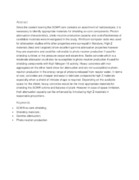Evaluation of candidate materials for SCWR turbine and balance of plant shielding
Abstract
Since the coolant leaving the SCWR core contains an assortment of radioisotopes, it is necessary to identify appropriate materials for shielding ex-core components. Photon attenuation characteristics, photo-neutron production capacity and cost effectiveness of candidate materials were investigated in this study. WinXcom computer code was used for attenuation studies while other properties were surveyed in literature. High Z materials (lead and tungsten) show excellent gamma attenuation properties however they are expensive and could be vulnerable to photo-neutron production if used for shielding turbines or the pressure vessel exit steam-line. Barite concrete which is a moderate attenuator could also be susceptible to photo-neutron production if used for shielding components with high Nitrogen-16 activity. Heavy concretes with iron aggregates on the other hand show fair attenuation and are not susceptible to photo-neutron production in the energy range of photons released from reactor water. In terms of cost, concretes are cheaper and easy to fabricate compared to high Z materials especially when a shield of intricate shape is required. Depending on the available space for the shield, heavy concretes would be the most appropriate materials for shielding the SCWR turbine and balance of plant. However in case of space limitation, their attenuation capacity can be enhanced by introducing high Z materials in reasonable proportions.
